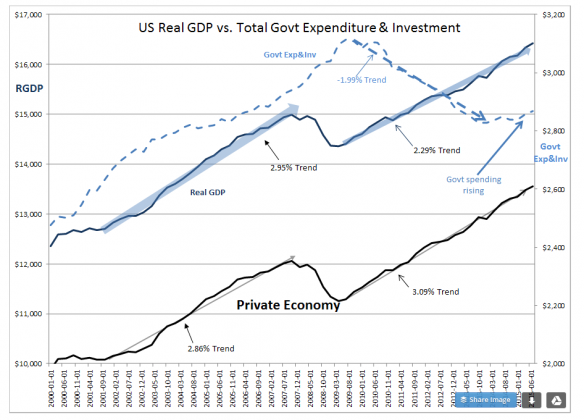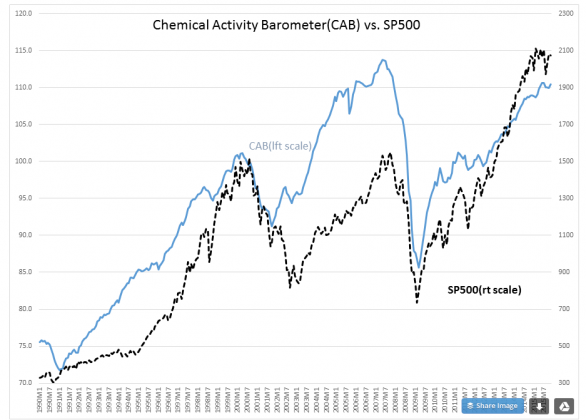There really is no reason for the Fed to hold off on rates hikes
I’ve been saying it for months now, when they start raising, we see economic activity increase as bank lending , which is overly restrictive now, will improve.
“Davidson” submits:
US Gross Domestic Product was reported higher than expected and past numbers were revised higher. With new data the trends can be calculated a little more accurately.
The current economic cycle has differed from the past only in the contributions from government spending. US Real GDP had roughly a 3%(2.95%) growth rate from Oct 2001 thru July 2007-see the DARK BLUE LINE in the chart. The current cycle has been closer to 2.3%(2.29%). The reason for this change has been the drop off in Govt Expenditure & Investment. In other notes it has been shown that slowing Govt Expenditure has been the reason for low inflation as government reduces historically inflationary military expenditures. It appears that Govt Expenditures may now be turning higher which historically has pushed inflation higher.
A better understanding of our economy comes when we look at the Private Economy. The Private Economy which is calculated by subtracting Govt Expenditure & Investment from US Real GDP and shown by the BLACK LINE is running at a pace near 3%(3.09%). The Oct 2001 thru Jul 2007 Private Economy grew at a similar ~3% (2.86%). Considering that several years from today we will see revisions in these reported values when doing ‘economic math’ using statistical methods both recoveries appear to have the same trajectory.
It should be clear that the often expressed view that there is nothing supporting stock prices but low interest rates has ignored the economic strength of the Private Economy.
The recent rise in Govt Expenditure & Investment is likely to push inflation higher which the Fed’s rate regime was unable to accomplish. Many will likely see higher inflation as ‘victory’ and praise the Fed for doing its job finally. Frankly, I think the Fed is misguided. We do better with low inflation in my opinion. But, consensus is consensus even if it is misguided. The new perception of inflation is likely to see funds flow from Fixed Income to Equities as investors adjust. Such a shift portends much higher equity prices including prices of Natural Resource companies.
My recommendation remains that investors favor Equities ($SPY) over Fixed Income.
Additionally:
The past 3mos of the Chemical Activity Barometer were revised higher with todays’ report. When one sees what appears to be a near term peak forming in any economic series, the revisions become more important when interpreting the data. Higher revisions confirm up-trends while lower revisions confirm down-trends.
This indicator continues to reach higher indicating along with US GDP, Employment, Retail Sales and Housing indicators that the economic expansion continues. Having passed a period of negative market psychology the past several months, we should expect new records in equity prices even with overhanging geopolitical events.
Finally, Brian Wesbury opines:
Real GDP was revised to a 2.1% annual growth rate in Q3, exactly as the consensus expected, from a prior estimate of 1.5%.
The upward revision was mostly due to inventories, while business investment in equipment was revised up as well. The largest downward revisions were for business investment in intellectual property as well as net exports.
The largest positive contribution to the real GDP growth rate in Q3 was personal consumption. The largest drag on growth was inventories.
The GDP price index was revised higher to a 1.3% annual growth rate from a prior estimate of 1.2%. Nominal GDP growth – real GDP plus inflation – was revised up to a 3.4% annual rate from a prior estimate of 2.7%.
Implications: Good news and bad news in today’s GDP report, which is exactly what we should expect given the Plow Horse Economy. The good news is obvious: real GDP growth in the third quarter was revised up to a more respectable 2.1% annual rate from a previous estimate of 1.5%. In addition, business investment in equipment grew at the fastest pace in a year, despite being weighed down by fewer oil rigs and drilling equipment. The pick-up in equipment should help boost future productivity growth. However, the biggest driver of the upward GDP revision was inventories, which can’t be relied on for long-term growth. In addition, corporate profits declined 1.1% in the third quarter and are down 4.7% from a year ago. The drop in profits was due to slower growth in advanced economies abroad and the stronger dollar, which pushed down profits earned abroad; profits earned domestically grew in Q3. In terms of monetary policy, today’s report continues to flash green for the Federal Reserve to start raising rates in December. Nominal GDP (real growth plus inflation) was revised up to a 3.4% annual growth rate in Q3 from a prior estimate of 2.7%. Nominal GDP is up 3.1% from a year ago and up at a 3.9% annual rate in the past two years. These figures show the Fed’s target of essentially zero for short-term interest rates is too low and monetary policy is too loose. On the housing front, the national Case-Shiller index, which measures prices across the country, increased 0.8% in September and is up 4.9% from a year ago. The largest gains in the past year have been in San Francisco, Denver, Portland, and Dallas. Given that national average home prices have already reached fair value, we expect the gains in home prices to continue, but at a slower pace over the next couple of years. In other news this morning, the Richmond Fed index, a measure of mid-Atlantic manufacturing sentiment, fell to -3 in November from -1 in October. Plugging this into our models suggests the national ISM index will be up in November, but only modestly.

